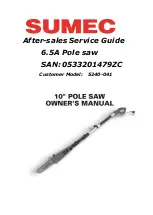
Definition of terms
Kerf
The gap formed when material is removed by the
moving blade.
Cutting line
The line along which the blade cuts through the
workpiece.
Saw set
A saw blade’s teeth are alternately set slightly
outward in order to prevent the blade jamming in the
kerf. The kerf is therefore wider than the blade
thickness.
Workpiece
The object being cut. The surfaces of a workpiece
are usually referred to as the top, bottom, front edge
and rear.
Longitudinal cutting
Sawing along the grain of the wood.
Angle cutting
Cutting at an angle to the surface of the workpiece
that is not a right angle.
Mitre cutting
Cutting at an angle to the front edge of the workpiece
that is not a right angle.
Double mitre cutting
A combination of angle and mitre cutting.
The bandsaw must only ever be operated from the
front or side.
Be sure not to install or operate the bandsaw in
damp or wet conditions.
7. Assembly
(Figure 1/2)
Caution! Pull out the power plug before carrying
out any maintenance or resetting work on the
bandsaw!
The bandsaw is preassembled at the factory. All you
have to do is fasten the machine table (13) to the
machine stand with the quick-release clamping
screw. Ideally you should bolt the bandsaw to a solid
worktop or workbench using the holes provided in
the machine foot. Check the data on the rating plate.
Voltage and frequency have to comply.
7.1 Adjusting the cutting height
The upper blade guide has to be adjusted in
accordance with the thickness of the workpiece.
Undo the fixing screw (2) and adjust the blade guide
so it is approx. 2-3 mm higher than the thickness of
the workpiece you want to saw. Re-tighten the fixing
screw. Check the setting before every cut and re-
adjust if necessary.
7.2 Changing the blade
Caution! Pull out the power plug before changing
the blade.
The blade is sharp! Beware of cutting yourself! Wear
safety gloves when carrying out any work on and
with the blade.
1.
Undo the fixing screw (2) and move the upper
blade guide unit to a position approx. half way
between the table and the frame.
2.
Release the two machine frame locks and open
the housing cover.
3.
Undo the two fastening screws of the blade
guard and remove the guard.
4.
Remove the table adjusting screw, washer and
thumb nut from the bandsaw table.
5.
Move the blade through the slot in the table as
far as the middle of the table, making sure that
the teeth face the front edge of the table and the
tips of the teeth point down.
6.
Remove all tension from the blade by turning the
tension button down.
7.
Now place the blade on the two blade pulleys
and align centrally on the pulley tyres (the rubber
surface on the pulleys).
Important!
Remove the tension from the blade if you are not
going to use the bandsaw for a while. Place a
notice to this effect on the machine where it
cannot be overlooked. Be sure to re-tension the
blade before you re-start the machine.
7.3 Tensioning the blade (Figure 5)
Caution!
Make sure the blade is tensioned before you
switch on the machine. The blade tensioning
device has to be locked.
Important!
The blade may break if the tension is too high.
Beware of injury!
If the tension is too low, the powered blade
GB
14
Anleitung BM 190-12 sprachig 16.10.2001 10:31 Uhr Seite 14
Содержание BM190/JDD 200
Страница 3: ...3 4 1 2 3 5 6 Anleitung BM 190 12 sprachig 16 10 2001 10 31 Uhr Seite 3...
Страница 68: ...4 m 1 2 20 m s o 1 18 16 T GR 68 Anleitung BM 190 12 sprachig 16 10 2001 10 31 Uhr Seite 68...
Страница 70: ...7 1 2 13 7 1 2 2 3 7 2 1 2 2 3 4 5 6 7 GR 70 Anleitung BM 190 12 sprachig 16 10 2001 10 31 Uhr Seite 70...
Страница 72: ...1 1 2 2 1 7 8 45 7 9 8 8 1 8 2 45 8 3 10 GR 72 Anleitung BM 190 12 sprachig 16 10 2001 10 31 Uhr Seite 72...















































